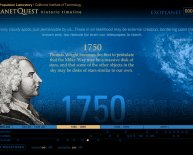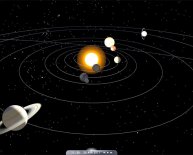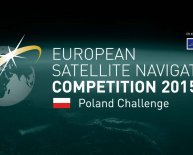
History of the solar system
Mercury
The innermost planet in our solar system, Mercury orbits our sun between just under 70 million and 46 million kilometers. Ancient astronomers knew of the planet's speed around the sun: Assyrian astronomers associated it with gods such as Nabu, the scribe and messenger to the gods, while the Greeks named the body Mercury, the messenger of the gods. The association is apt: the planet has a short year of 88 days in all.
In 1631, astronomer Pierre Gassendi first observed Mercury making a transit across the sun, and just a couple of years later, another astronomer, Giovanni Zupi discovered phases, indicating that the planet orbited the sun. Other astronomers followed, making incremental discoveries along the way: Italian Astronomer Giovanni Schiaparelli observed the planet, and concluded that Mercury was tidally locked with the sun.
More discoveries came during the modern era of space exploration: much more about the planet has been found recently. Soviet scientists first used radar to study the planet in the early 1960s, while scientists at Puerto Rico's Arecibo Observatory Radio Telescope discovered that the planet in fact rotated once every 59 days, rather than 88 as previously thought. In 1974, Mariner 10 first visits the planet, making several passes, mapping the surface, and in 2008, the MESSENGER satellite marked a return to the planet, where it's currently in orbit.
GIF
Venus
The second planet in the solar system, Venus is the brightest of the planets as observed Earth. As a result, it's been studied since ancient times, with the first records coming from the Babylonians, who named the planet Ishtar. The Romans viewed Venus as the goddess of beauty, while the Mayans believed that the planet was the brother of the Sun. In 1610, Galileo Galilei observed phases of Venus, confirming that the planet did indeed orbit the sun. Due to the planet's thick atmosphere, observation of the surface wasn't possible until the 1960s, but many believed that Venus harbored life, due to the planet's similar size to Earth.
In 1958, radar imagery found that the planet's surface was hot – inhospitably so. Mankind was about to get a closer look. The first attempt, the Soviet Union's Venera 1, launched in 1961, failed, but Mariner 2, launched by the United States, succeeded in a flyby confirming the planet's temperature and that it lacked a magnetic field. A new Soviet mission, Venera 4, successfully reached Venus and sent back information about its atmosphere before it burned up during entry. Several additional probe followed: Mariner 5, Venera 5 and 6, before Venera 7 successfully landed, becoming the first manmade object to land on another planet while Venera 8, landed two years later. Both were destroyed by the planet's heat and pressure, but the Soviet Union continued to send probes: 9 through 12 took pictures and gathered information on the planet's geology. NASA also continued to send probes: Pioneer 12 orbited the planet for 14 years, mapping the surface, while Pioneer 13 sent several probes down to the surface.
Earth
Earth has been continually observed by humanity as long as we've been around. But, while we knew we stood on solid ground, the true nature of our home took a little while longer to figure out. For many centuries, humanity believed that Earth wasn't an object such as those that they observed above them: everything was thought to revolve around us. As early as Aristotle, philosophers had determined that Earth was spherical by observing its shadow against the Moon.
Mikołaj Kopernik – known as Nicholas Copernicus posited a Heliocentric view of the solar system as early as 1514. Titled De revolutionibus orbium coelestium (On the Revolutions of the Heavenly Spheres), the book was first published in 1543, challenged the conventional wisdom of the day. The theory was controversial, but was followed up by Johannes Kepler with his three volume work, Epitome astronomiae Copernicanae (Epitome of Copernican Astronomy). Kepler had devised three laws of planetary motion: "Planets move around the Sun in ellipses, with the Sun at one focus", "the line connecting the Sun to a planet sweeps equal areas in equal times" and "the square of the orbital period of a planet is proportional to the cube (3rd power) of the mean distance from the Sun in (or in other words—of the "semi-major axis" of the ellipse, half the sum of smallest and greatest distance from the Sun)". These laws helped define the motion of the planets and allowed us the first real idea that our solar system was vastly different than previously thought. Kepler's theories weren't popular at first, but eventually caught on in Europe. At the same time that Copernicus was publishing his views, Ferdinand Magellan's expedition was able to circumnavigate the globe in 1519.
However, it wasn't until October 24th, 1946 when we first got a look at our home world when the first picture of Earth was taken from a modified V-2 Rocket fired from the White Sands Missile Range in New Mexico.
Mars
The blood-red fourth planet of our solar system has long been associated with the Roman God of war, bearing the same name: Mars. Where many people thought that Venus might very well enjoy an earth-like atmosphere, there were similar thoughts about Mars. Most notoriously, astronomer Giovanni Schiaparelli examined the planet through a telescope in 1877, describing a number of features, which he described as Canali. The mistranslated word was understood to mean that he had discovered Canals on Mars, and by extension, people assumed that they were artificial. Twenty years later, another astronomer, Camille Flammarion, further identified the features as artificial, and the general public generally assumed that the planet could support life. Undoubtedly, the public's perception led to the rise of a number of Mars-oriented SF novels, such as The War of the Worlds, by H.G. Wells, and Edgar Rice Burrough's John Carter series.

















